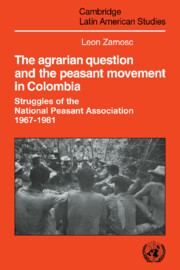 The Agrarian Question and the Peasant Movement in Colombia
The Agrarian Question and the Peasant Movement in Colombia Book contents
- Frontmatter
- Contents
- List of tables, figures, and maps
- Foreword by Tedor Shanin
- Foreword by UNRISD
- Acknowledgments
- List of abbreviations
- Map 1 Republic of Colombia
- Introduction
- 1 The agrarian question in Colombia
- 2 Reformism and the beginnings of the peasant movement
- 3 The radicalization of ANUC and the great waves of land invasions
- 4 Counterreform
- 5 The contradictory influences of peasant politicization
- 6 Concessions and repressive escalation
- 7 The new occupational alternatives and the issue of the rural proletariat
- 8 Partial repeasantization and the question of the new peasant settlements
- 9 Final crisis and clientelist regression of ANUC
- 10 Overview and final remarks
- Notes
- Bibliography
- Index
- Cambridge Latin American Studies
7 - The new occupational alternatives and the issue of the rural proletariat
Published online by Cambridge University Press: 10 October 2009
- Frontmatter
- Contents
- List of tables, figures, and maps
- Foreword by Tedor Shanin
- Foreword by UNRISD
- Acknowledgments
- List of abbreviations
- Map 1 Republic of Colombia
- Introduction
- 1 The agrarian question in Colombia
- 2 Reformism and the beginnings of the peasant movement
- 3 The radicalization of ANUC and the great waves of land invasions
- 4 Counterreform
- 5 The contradictory influences of peasant politicization
- 6 Concessions and repressive escalation
- 7 The new occupational alternatives and the issue of the rural proletariat
- 8 Partial repeasantization and the question of the new peasant settlements
- 9 Final crisis and clientelist regression of ANUC
- 10 Overview and final remarks
- Notes
- Bibliography
- Index
- Cambridge Latin American Studies
Summary
As indicated in the previous chapter, one of the main purposes of the Sharecropping Law was to alleviate social pressures in the areas of extensive landed property. If the landless were trying to take the land by force, it was because they wanted to establish an independent peasant economy that would guarantee their subsistence. To avoid the land struggles and preserve the existing structure of property, it was necessary to provide other occupational alternatives for the rural population. The reintroduction of rent and sharecropping appeared to be a possible strategy to achieve greater employment without agrarian reform. However, although the Sharecropping Law would have important effects, other factors were already operating in the same direction by the mid–1970s.
Migration and employment options
An examination of statistical data on rural unemployment is a convenient way to approach this question of occupational alternatives. According to information from the population censuses of 1964 and 1973, the rate of overt unemployment in the countryside had decreased from 7.2 to 3.9 percent during the intercensal period. In 1978, a special study by DANE showed that overt unemployment had decreased further to 1.6 percent of the rural labor force. The same study estimated a rate of disguised unemployment of 1.5 percent, for an overall rate of 3.1 percent.
- Type
- Chapter
- Information
- The Agrarian Question and the Peasant Movement in ColombiaStruggles of the National Peasant Association, 1967–1981, pp. 130 - 145Publisher: Cambridge University PressPrint publication year: 1986


